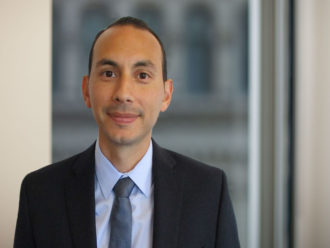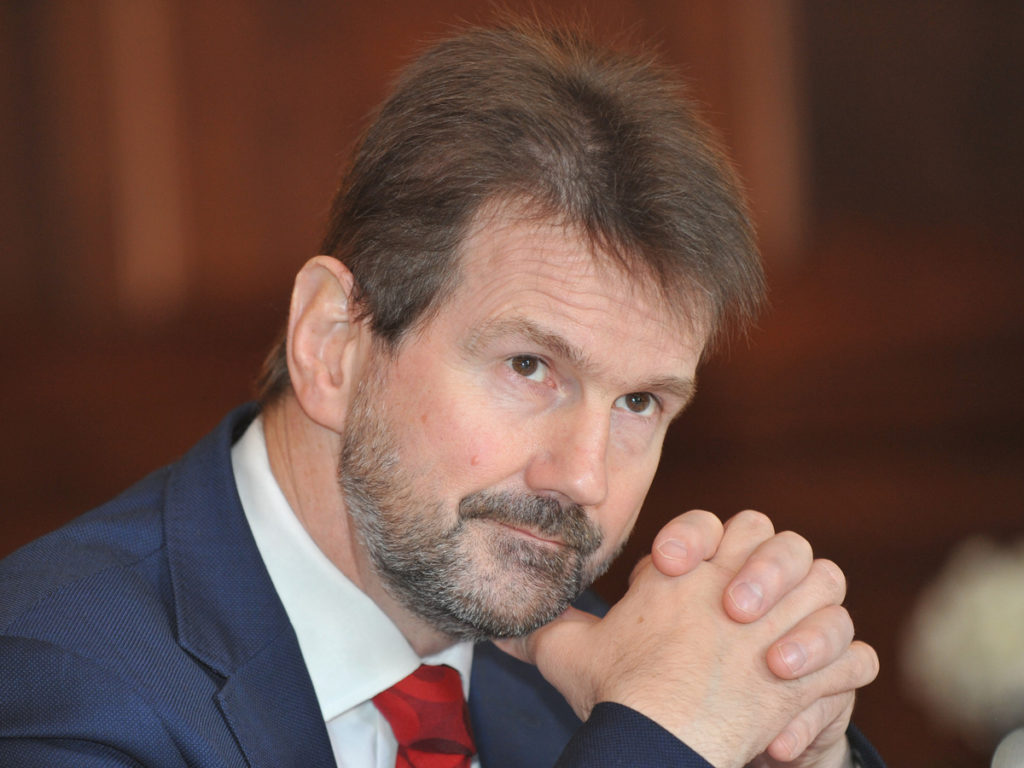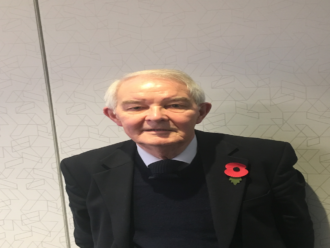The national lockdowns ordered in response to the Covid pandemic a year ago have caused economic uncertainty. Many businesses, such as high street retail and leisure, have been hit hard as many were forced to stop trading. The uncertainty has left market watchers to question if some corporates can afford to repay their debts. If not, downgrades could be on the way.
Marks & Spencer, Heinz and Virgin Money are just some household names that have lost their investment-grade status in recent years and are now graded as fallen angels as they are now classed as high yield. Could others be about to join them at the risker end of the spectrum and if so, how can investors spot a bargain? To find out, we brought asset owners and asset managers together with consultants and a credit strategist to examine the fallen angel market.
Watch the roundtable
Participants

Manuel Hayes, director, senior portfolio manager at Mellon
Manuel Hayes is a senior portfolio manager responsible for managing investment grade and high yield cash strategies. He actively works with credit researchers to develop new investment grade and high yield strategies. Additionally, Hayes has pioneered innovation in bond trading with “bond basket” trading to enable lower transaction costs, scalability and enhanced liquidity in the credit space. Previously at the firm, he served as the primary credit trader on all global investment corporate, high yield, emerging market hard currency, sovereigns and municipal bonds. Hayes has been in the investment industry since 2004.

Kate Hollis, senior investment consultant, Willis Towers Watson
Kate Hollis joined Willis Towers Watson in Sept 2014 as a Manager Researcher on the fixed-income team. She previously spent 10 years at S&P Capital IQ, most recently as global head, fixed income/alternatives fund research. Before that she spent 5 years working for funds of hedge funds and 15 years in fixed-income sales and trading in London and New York, working for Deutsche Bank, Daiwa Securities, Scotia McLeod and Schroders.

Anand Kwatra, investment actuary, Phoenix Group Capital
Anand Kwatra works for Phoenix Group Capital, which is responsible for the shareholder investment strategy and other risk management initiatives for Europe’s largest consolidator of closed life funds. The group has sourced over £2bn of illiquid credit since 2017, which includes assets like equity release mortgages, private placements, green bonds & social housing. He has a range of insurance investment experience covering private credit, origination, internal rating and asset liability management.

Stuart Trow is credit strategist at European Bank for Reconstruction & Development (EBRD)
Stuart Trow joined EBRD after a career on the sell side. As Credit Strategist his role spans high grade credit management, emerging market strategy and ad hoc portfolio “firefighting”. Previously he was head of EU credit research at National Australia Bank and prior to that was head of market and credit analysis at Norinchukin International. He graduated from the London School of Economics in Mathematical Economics and Econometrics. He wrote the first several editions of The Bluffer’s Guide to Economics, which was also translated into French, Dutch, Portuguese, Chinese and Slovenian.

Dinesh Visavadia, director, Independent Trustee Services (ITS)
Dinesh Visavadia, who joined ITS in October 2016 has a background in managing domestic and international pension arrangements with some of the UK’s most prominent employers. Most recently he was the head of pensions and benefits at Britvic Soft Drinks prior to which he was head of pensions at the John Lewis Partnership.

David Weeks, Co-chair Association of Member Nominated Trustees
portfolio institutional: Is this a good time to follow a fallen angel strategy?
Manuel Hayes: We at Mellon believe it is. The large BBB bloat in the corporate bond market, which is expanding thanks to an increase in large issuance, is a nice back drop in this pandemic for more downgrades to take place.
In 2020, there were $200bn (£144bn) of downgrades in the US, across 270 bonds issued by 50 companies. It was an unusual amount, but in this pandemic with a BBB bloat overhang, 2021 should see an increased pace of downgrades. Only half of the downgrades seen in 2020 would provide a nice tailwind for investors to harvest.
We have analysed big shocks, such as the great financial crisis, and fallen angels have strong returns in the subsequent year. If you expand that window by two to three years, there is a strong performance in the asset class. If 2021 rhymes with the past, we are in a good period to invest in fallen angels.
Kate Hollis: Fallen angels have a structural premium, but most of that comes within a year or two after a downgrade. While there will be more fallen angels this year, it is unlikely to be on the scale of last year.
Dinesh Visavadia: Because the opportunity after such an event is for one to three years at the most, there is not the agility in trustees’ decision making to take advantage of this. By the time you do any- thing the opportunity is only half there, so it is often ignored.
Stuart Trow: We have had downgrades without defaults getting out of control, so it is fertile ground. Added to which, spreads in the high-yield space are not back to where they were. That creates value for those who look at spreads rather than yields, whereas the BBB space is back to where it was. On a relative value basis, I am more enthusiastic about fallen angels than a lot of areas on the curve.
David Weeks: In the short term, the factors through which our members consider fallen angels are: diversification, spread, risk and liquidity for transfers. Long term, they tend to have their strategies in place and are not looking for short-term shifts. High in their consideration for short and long term, will be how regulators view investments in fallen angels.
PI: Anand, as an insurer you prefer investment-grade debt, but would you consider investing in a bond at risk of becoming a fallen angel?
Anand Kwatra: We are heavily regulated by the Solvency II environment, so follow a conservative buy-and-hold strategy. In our world, we are penalised by defaults and downgrades. We have a low appetite for BBB-risk because if it is downgraded and becomes a fallen angel our capital requirements increase substantially.
The only way we would consider invest- ing in the BB or B spaces is if there was some form of credit protection. For exam- ple, if there is a highly rated sovereign or multilateral development bank, such as the World Bank, guaranteeing the debt. This protects us from credit risk on the underlying.
PI: Have you increased your exposure in the past year, Manuel?
Hayes: We have. There are a lot of oppor- tunities. In every month in the past year there has been a downgrade, except for January which was unusually quiet. Even as we speak, downgrades are taking place. The biggest appeal for us is the discount that they come into the high-yield space at.
Credit markets are an inefficient market structure. You are either an investment grade portfolio manager, trader, analyst or a high yield manager, trader or analyst. There are not too many places where you have synergies across the spectrum. Some active investors are forced to sell because of capital constraints, while indexers sell if a bond is no longer in an index. Force selling causes discounts.
These bonds are coming into the high yield area cheaper than they should be.
PI: Such bonds were downgraded for a reason, so how do you assess a new fallen angel?
Hayes: We use a quantitative systematic approach where we look to harvest a diversified profile across our fallen angel and high yield strategies. This allows diversification and not too much idiosyncratic risk. From a portfolio design perspective, it allows us to harvest the structural premia, buy it and implement it cheaply.
Trow: It is a type of arbitrage and you are looking for returns that you cannot get from the BB space. People are afraid of the funding requirements or do not want to be around a name associated with bad news.
BB is not a million miles away from BBB in terms of credit quality, so if you are prepared to do the work and sort the wheat from the chaff you do not want to buy something that is BB but is about to be B. It is a relative value trade as much as anything else.
Hollis: The fallen angel premium is created by investors reacting to the artificial break between investment grade and high yield. Because it sets up structural cheapness, a strategy that invests systematically in fallen angels, should earn excess returns over the long term, but returns will be concentrated in periods like now, where there has been a large wave of downgrades.
Kwatra: Ultimately, it is integrating the range of concepts surrounding how you manage risk and return. You need to have a rigorous security selection in this space where there is heightened risk. It is important to question why the debt has been downgraded: is it part of the sell off or are the fundamentals weakening?
You also need to have sound internal processes because the volatility may present you with opportunities which require you to be agile to take advantage of any temporary dislocations, like we saw in March 2020. Another consideration is managing downside risk. If you are in this high yield strategy, you need clear risk appetite parameters, like capping your applications to lower ratings such as B.
PI: How are you navigating defaults?
Hollis: There are very few companies that go smoothly from investment grade straight to default. When that happens, it is normally associated with fraud, like Wirecard. I am not saying it cannot happen, but generally downgrades are associated with nancial or operational activities that the rating agencies are able to monitor and signal their concerns in advance using their outlook ags. There are normally signs that something is about to be down- graded. It is not that everyone has been caught on the hop.
A fallen angel strategy is improved by having a screen for companies that are suddenly downgraded by several notches because it is a signal that there may be something nasty hiding in the woodshed. It is not a perfect defence, but it is better than nothing.
Weeks: Marks & Spencer is a fallen angel. It has seen a long-term decline in market capitalisation, which is a worry. A poor range of merchandise, which is a worry. A reliance on an outdated property portfolio, which is a worry. British Airways, in contrast, has seen short-term turmoil but some bounce back is probably ahead. Some people say that Virgin Money’s brand image is a bit tarnished compared to previous years, so there may be a long- er-term problem there. Finally, a decline in advertising revenue at ITV is probably more serious.
PI: If defaults are usually signposted, are other factors higher up your agenda when looking at fallen angels, Manuel?
Hayes: Risk mitigation is key. Fallen angels are a higher quality segment. In the past 15 years, they have had 0.6% defaults on a par-weighted basis, while broad high yield has 1.61%. It is less than broad high yield since it is higher quality. You always have to mitigate falling knives or the big jumps that happen from investment grade to something much lower.
At some point the structural premia, the value that is initially presented, goes away and BB companies may continue to deteriorate. So, at some point you have to look at the fundamentals and ask if a company’s leverage is too high or its low profitability will continue to deteriorate over time verses their peers. You have to have that mechanism in place to mitigate and monitor that exposure.
PI: What impact is the economic uncertainty having on risk assessments?
Hayes: No one has an answer as to when things will stabilise and companies will rebound. We are excited about the volatility. We take a quantitative systematic approach and so any period of dispersion is good for models to differentiate between winners and losers. We like volatility and we like downgrades.
Visavadia: On one hand the pandemic is causing uncertainty in the markets and on the other some tech company valuations are sky high. This is a recipe for disaster. Therefore, trustees shy away because this is beyond their risk spectrum. That is a big challenge. This is a good asset class but given the timing a lot of trustees might shy away because there is only one way for this market to go. Could I ask, to what extent have downgrades been exaggerated by poor ESG credentials?
Hollis: Some issuers that have been downgraded lately have lower than expected ESG credentials. That is not so much an ESG effect per se, it is a function of the oil price trading negatively last year. Occidental, as an example, did an aggressive merger a year or so before Covid, so its financial metrics changed and became more risky.
This is different from thermal coal companies at the bottom of the CCC spectrum where ESG is going to have a different effect and the industry is in long term decline. Some retail is in long-term decline due to online competition, but that is not so much an ESG effect. Avoiding issuers with long-term ESG headwinds which make them less likely to bounce back is probably a good idea.
Trow: There are structural changes that the pandemic has accelerated. People hosting conferences online has had a knock-on effect for airlines. What I am nervous about with ESG is that it is difficult to quantify. It is obvious if you are a coal miner, but if you are in the middle and your ESG rating is not great, but it could be improved, or a green company with little to add to the story, the regulators are not clear what direction they want to take. Is it a reward for people improving? Or only in favour of green industries?
That has led to confusion about what is green. In high yield you find private equity-owned firms focusing on green transactions. The cynic in me thinks that they are after tighter spreads. If you get a rigorous groom judging these ESG standards, you may be in a more di cult situation than you would be with a vanilla bond.
Hayes: ESG is important. Clients demand it. Environmental, social and governance issues are highly relevant in today’s markets, but they do not heavily influence a rating agency downgrade. Rating agencies are traditional. They look at fundamental balance sheet information, leverage metrics and cash flows. Hopefully, at some point ESG becomes more relevant to rating agencies, but today if bonds are downgraded, it is based on the traditional metrics.
Weeks: Rating agencies are creeping high up on the agenda for trustees to get accurate data. The E tends to be top of the list. G is creeping up, with Tesco’s accounting problems an example of why.
Tobacco is high on people’s agenda. With the number of smokers gradually reducing, is this a good time to bail out? But on the other hand, the dividends are good. Trustees deciding when to pull the plug is the issue.
Kwatra: It is about balance. You have to pay attention to the rating agency, but that is no replacement for scrutinising the asset yourself. There is an onus on the investors to understand what is driving the fundamentals: why has it been down- graded and what are the prospects for a reversal? As a buy-and-hold investor, we get scrutiny from the regulator not just to align what our rating agency says, but to form our own internal view and essentially own the risk.
Visavadia: Rating agencies are important. As an investor you want to take as much information from the market as possible. Rating agencies focus more on a quantitative assessment, but there are a lot of other commentaries out there, like fund manager reports and consultants who provide opinions. We pay attention to rat- ing agencies, but we listen to other people at the same time. No one person is going to tell you the full story. It makes the life of a trustee more difficult, but it is the right thing to do.
Hollis: You could do research forever and you would never be finished. Not even a CFO has perfect knowledge of his company’s finances. There is a point where you have to say that further effort is not going to be rewarded with further information and draw a line. It is knowing when you have answered your questions, and identified the potholes, then you rely on your judgement and monitor it to see if you are right.
Trow: Generally, people are more comfortable with investment grade because it is more homogeneous. If you get a far more dispersal around mean credit spreads in high yield, it is an opportunity if you do the relative value and fundamental work to see if the apparent relative value is real or not. Effectively, rating agencies create the fallen angel arbitrage.
Hayes: This is something, especially in the investment grade universe, that lags. It has improved over the years, their metrics are getting better as data is becoming more relevant, accessible and easier to digest, but they do lag. We have looked at the analysis of all fallen angels as they have been downgraded in the past 15 years.
What has become obvious is that even six months before a downgrade from investment grade to high yield, you will see the market pricing it in. The market is more efficient, understands information, is faster moving and easier to digest. You will see under performance of these investment grade bonds as they start slowly getting migrated, the market sees it and prices that in. To that degree, the market is more efficient than the rating agencies. I am not saying they are bad, just slower moving.
PI: How are you accessing liquidity in this market, Manuel?
Hayes: Liquidity has never been better in the fixed income markets, but it depends on how you access it, where these pockets of liquidity are and how you curate it. Traditionally, fixed income has been illiquid, especially in high yield. You phoned your broker 10 years ago and were trading by appointment, but the market has evolved.
The growth of ETFs has been the catalyst that bridges the gap between the great liquidity you see in the equity markets and the fixed income markets. They are not on the same level, but it is evolving, getting better – and that is exciting if you know how to access it. That is a big if. People still call brokers and there will be a need for that. They have the balance sheet and can make markets on specific bonds, but there is a larger ETF ecosystem that is being built into the fixed income markets. If you can access it, you could buy bonds cheaper and do it in size and scale.
Weeks: Trustees are aware of the need for money for transfers. They will also be aware of the risk of getting out of investments if a fire sale is necessary, so liquidity is high on their list.
Visavadia: How much of an issue is liquidity? There is so much money being printed by governments and it has to be parked somewhere. Every sector of the market will have a reasonable amount of liquidity.
If 2021 rhymes with the past, we are in a good period to invest in fallen angels.
Manuel Hayes, Mellon
PI: What impact has central bank stimulus had on fallen angels?
Trow: Rates are low and the economic out- look uncertain, so people have kept their funding requirements to a minimum. There is not as much supply out there as you would hope.
Investors have been trying to find pockets of liquidity while issuers have kept their heads down. If they are issuing, they are doing it in tandem with tender offers or pre-funding several months or years hence.
What we are beginning to see in the whole credit market is that we have cannibalised potential issuance for the next year or two. We might be in a situation where fallen angel strategies are ideal because people are scrapping around for anything to buy with a bit of spread.
Hollis: Central bank buying has not done very much to tighten high yield spreads because they did not buy very much high yield debt. It did a lot for confidence but little in terms of dollar and cents for the overall market. But the Fed’s announcement was a huge game changer for sentiment on credit, especially fallen angels, as they said recently downgraded issues, including Ford, were eligible for Fed buying.
That was announced when the market was in panic mode and fallen angels were being sold o left, right and centre. On the day of that announcement the sell o stopped, went into reverse and fallen angels outperformed bonds that were originally issued as high yield by a significant amount.
Hayes: The Fed needed to step in and stabilise the entire risk market spectrum, including equities. Liquidity had almost evaporated, markets were dislocated and companies could not issue debt. The Fed coming in provided a floor. Although it did not buy much in dollar terms, it showed the market that central banks are willing to step in when needed.
The Fed officially stopped buying corporate debt at the end of December. Is that a risk or a concern? No. We have seen its willingness. If the markets go back into disarray, in the markets’ mind there is a backstop in that central banks will step in and provide stability.
Kwatra: The narrowing of investment grade spreads is intensifying the search for yield. In our world, it is intensifying the search for private credit and illiquids across the investment grade spectrum.
Visavadia: Most pension schemes are positioned to take advantage of fallen angels through their credit portfolios. To get the yield, they invest in sub-investment grade. Some of my managers look at deep value, distressed debt and high yield. I am sure these funds will take advantage of investing in fallen angels in the next 12 to 15 months.
PI: What do you expect to see in the fallen angel market during the next 12 months?
Hayes: We are optimistic. The large BBB-bloat and $900bn (£648bn) of debt outstanding are levels we have never seen before. On the fundamental side, leverage is at an all-time high. Combine these issues and concerns with the pandemic and it causes uncertainty, which excites me. From a cynical side of things, I am looking forward to every downgrade. If someone is willing to force sell investment grade bonds at huge discounts, I will be happy to take the other side of that.
Kwatra: We are cautious on BBB investments, by virtue of penal capital requirements as mentioned earlier. There is an expectation of certain sectors continuing on a downward trajectory, but we are also seeing signs of recovery. We navigate by sticking to the safer, less cyclical sectors, so the bonds moving into riskier territory are the ones we are not focused on.
Trow: I am positive, with a caveat that we do not see a risk sell off. Fallen angels are interesting in the context of a risk rally, but what concerns me is that people are pressing for longer tenors, especially if you invest on a yield basis where you will get killed if benchmark yields turn quickly. With downgrades not necessarily filtering through to defaults, it is an attractive space, but that is in an-all-things-being-equal scenario.
Hollis: At the end of a long risk rally, when there have been a few fallen angels, several rising stars and a lot of maturities, you could have a fallen angel strategy that is concentrated by name and sector. At that point, you need to ask if those assets still do the job you want them to.
Visavadia: If there is a recognition by asset managers that there is a dislocation between investment grade debt and fallen angels, they will do something about it. They will get better quality research, which could benefit investors at the end of the day.
Weeks: The two groups trustees will be interested in are one, the regulators, and how they will see the market, and two, the specialists, especially if we have enough of them, or not, to navigate this newish sector, will be high in their minds.





